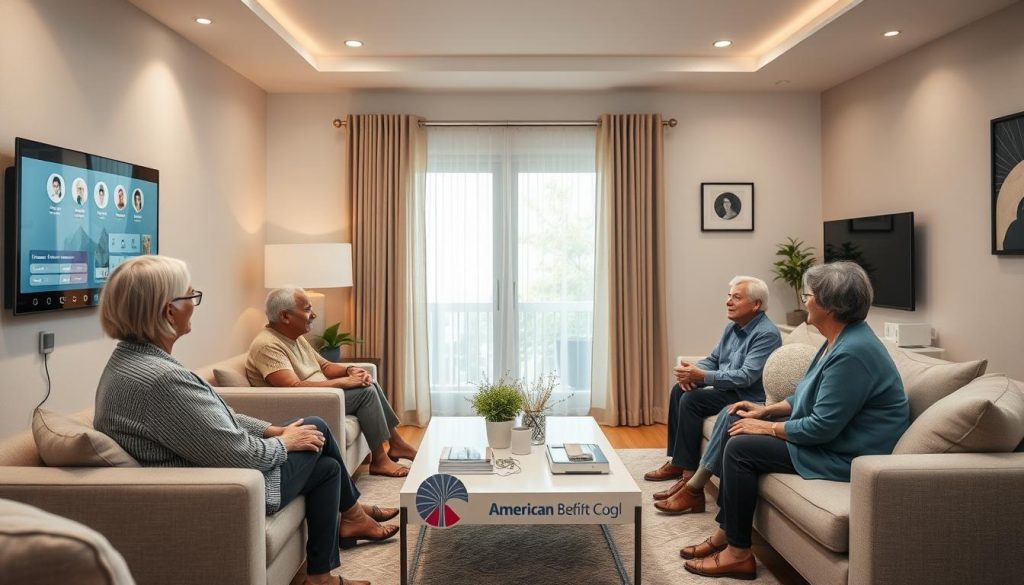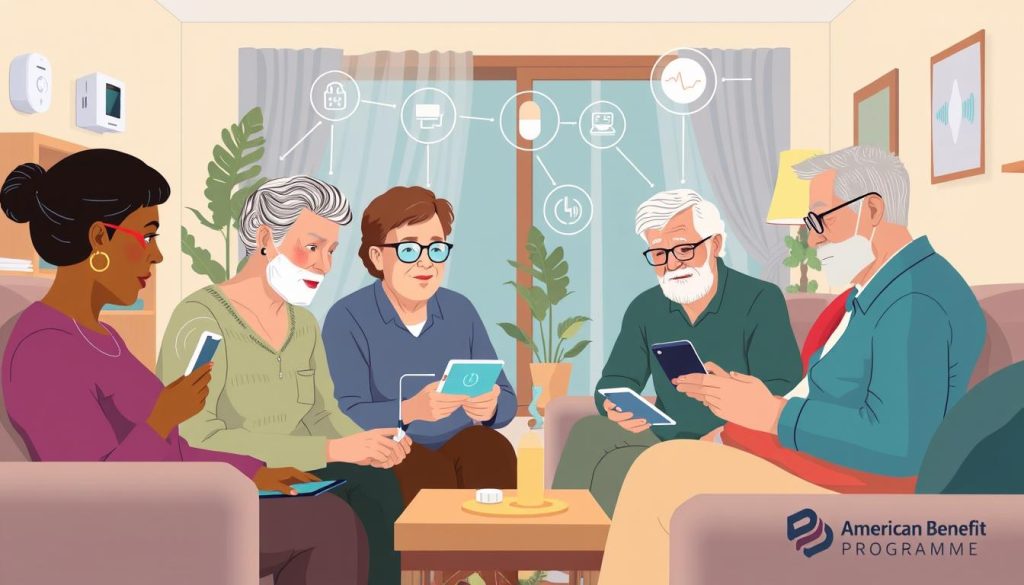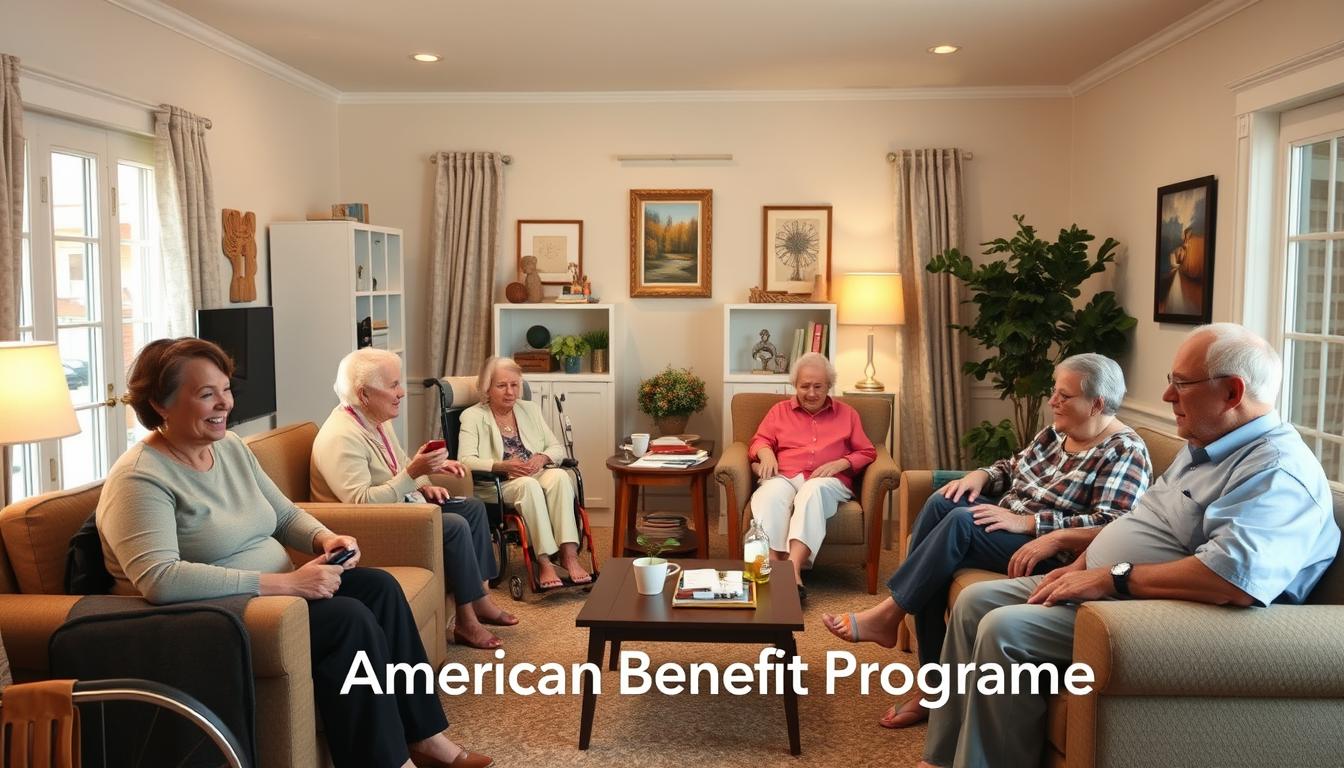How can technology help older adults stay independent in their homes? As technology for seniors gets better, aging in place technology becomes more important. It helps them live safely and happily at home. Now, over 75% of people over 50 want to stay in their own homes instead of moving to a care place. This shows a big move towards living on their own and taking care of themselves1.
Things like smart home gadgets and health check devices from afar are very important. They help a lot in making this choice work. They make sure older people are safe. But they also help them feel better in many ways. Let’s look at the tech that helps seniors stay at home. We will see how these tools make their everyday lives better. They can grow older without worries.
Key Takeaways
- Aging in place technology enables older adults to live independently at home.
- Over 75% of adults aged 50 and above prefer to stay in their homes as they age.
- Technological solutions can improve safety, health monitoring, and mental engagement for seniors.
- Smart home systems significantly contribute to enhancing daily living activities.
- Remote health monitoring is becoming increasingly popular with older adults.
- There is a need for more integrated aging-in-place systems to accommodate diverse needs.
Understanding Aging in Place
Aging in place lets seniors stay independent in their homes. A huge 93% of U.S. adults over 55 support this2. It keeps their minds, bodies, and social lives healthy. Nearly half of older people see aging as a reason to use helpful tech2.
Being in familiar places helps them manage daily life and make friends. It really boosts their happiness as they get older.
Moving to care facilities can make health worse. So, it’s key to have tech that helps people stay at home. Now, 61% of elders have smartphones, showing they’re getting into tech2. More than half say this tech helps them feel more free2.
Still, 70% who don’t use tech think they don’t need it. And 16% find it too expensive2. But, using tech must be easy and simple. A recent survey showed that 75% think ease of use is key2. Also, 50% said easy setup matters a lot2.
To improve aging at home, understanding these tech needs is important. It helps us make better tools for living independently.
The Importance of Aging in Place Technology
Technology for aging in place is key to a better life for seniors. It helps them stay independent and gives their families peace of mind. With more older adults, the need for this technology is growing fast. It makes sure seniors can live at home safely and comfortably. For example, wearable tech watches health all the time. It spots health problems early3. Also, smart home tech adds safety with special lights, temperature, and security3
Now, seniors can use secure telehealth like Zoom for Healthcare and Teladoc from home4. AI robots also help with everyday things, like cooking and reminding about pills3. With these tools, caregivers can better watch over their loved ones. This makes giving the right help easier. All these devices make homes safer and work better. They let elderly people live with pride and on their own.
Key Areas Supported by Aging in Place Solutions
Aging in place solutions help older adults stay at home safely. They focus on many important areas needed for everyday life. These are cognitive and physical health, mobility, safety, connecting with others, and feeling well mentally. By 2060, around 96 million people in the U.S. will be 65 or older5. So, technology that helps seniors live at home is more important than ever.
Smart home devices make life better for seniors in many ways. Devices that keep the mind active help lessen the feeling of being alone. This is because they help seniors stay in touch with friends and family. As a fact, 94% of older people want to grow old in their own homes. This shows they greatly prefer solutions that let them live at home with the help of technology6.
One important solution is remote health monitoring. It keeps track of important health signs for older folks. This is vital since 78% of people over 55 have at least one long-term health issue5. These systems let caregivers know if there’s a health problem quickly.
Also, managing medications is key, making sure seniors take their medicine correctly. One survey found that 30% of older adults plan to use technology for home care. They see automated dispensers as very useful6.
Here’s a comparison of the most popular aging-in-place technologies:
| Technology | Description |
|---|---|
| Video Doorbell | Enhances security by allowing remote monitoring of the front door. |
| Voice and Remote Thermostat | Optimizes home temperature, improving overall comfort. |
| Virtual Assistant | Facilitates hands-free tasks and reminders through voice commands. |
| Stove Fire Prevention Devices | Reduces risk of kitchen fires, promoting safety. |
| Home Monitoring Systems | Enables real-time monitoring of the home’s environment. |
| Social Media Platforms | Encourages social interaction and connection among seniors. |
| Watches with GPS Capabilities | Supports safety and emergency response, particularly for those with memory issues. |
| Online Grocery Delivery | Provides convenience and accessibility for seniors’ shopping needs. |
| Telehealth | Offers medical consultations without the need to travel. |
By focusing on these crucial areas, aging in place tech helps seniors remain independent at home.
Smart Home Systems for Seniors
Smart home systems help seniors live alone safely. These elderly technology products let users control their homes. They manage lights, heat, and security from one spot or an app. The smart home market will grow to $165 billion by 2025. So, smart home technology is getting more common each day7.
About half of women over 75 live by themselves. Nearly half of them need safer homes with no hazards7. Smart homes can make their homes safer. For example, smart doorbells let caregivers know when someone visits. Smart sensors watch for movement and tell families about danger.

Research shows seniors use technology to stay in touch and have fun7. Many people over 50 want to learn about smart homes. They also like streaming shows and video chatting7. This interest means more seniors will use smart homes. This makes living safer and comfier for them.
More people are getting older, with over 77 million over 60 in the US8. Smart homes are becoming very important for them. Aging in place technology keeps seniors safe from dangers. It also lets them enjoy living in their homes longer.
Popular Aging in Place Devices
A lot of elderly technology products change how seniors live. They bring comfort and keep them safe as they age at home. Currently, 34 million people over 65 are choosing to age in place. This number may jump to 48 million by 2050, AARP9 says. Devices like Amazon Echo and Google Nest are very popular. They let users manage their home, talk easier, and remember medicine and meetings.
Automated pill dispensers are key for managing many medicines. But, seniors might need help setting them up and filling them. Studies show users want clearer instructions for devices that call for help if they fall9. Knowing how to use them right and avoiding mistakes is very important.
Smart wearables are also important. They track activity and health signs to promote a better lifestyle. Studies found that seniors get more confident with smart tech over time, not all at once9. The industry for active aging could grow to $30 billion. This shows how big and important these elderly technology products are for a good life10.
Overall, tech helps meet seniors’ needs and lets them live on their own safely.
Remote Health Monitoring Technologies
Remote health monitoring technologies help seniors live better. They check health data and cut hospital visits. This gives older adults more control over their lives.
Wearable Devices for Vital Signs
Devices like smartwatches and fitness trackers are key. They track heart rate, blood pressure, and oxygen levels. This helps find health issues early, which is important for seniors11.
Benefits of Remote Health Monitoring
These systems do more than just gather data. They let doctors spot trends and act fast when needed. RPM has helped heart patients avoid hospital stays11. Studies also show that these systems keep seniors safe at home by watching their daily activities and health12.
The eNeighbor system shows how well remote monitoring works. It uses sensors to notice if daily routines change. Studies show that RPM makes patients happier and improves health care11.
| Feature | Wearable Devices | RPM Systems |
|---|---|---|
| Primary Function | Monitor vital signs | Track daily activities and health metrics |
| Patient Engagement | High user engagement | Increased health empowerment |
| Health Outcomes | Early detection of issues | Reduced hospital readmissions |
| Technology Used | Smartwatches, fitness trackers | Advanced sensors and alerts |
New tech lets seniors stay healthy at home. It proves that aging in place technology is important.
Medication Management Solutions
As more adults get older, it’s important to help them stay healthy on their own. By 2050, about 82 million people in the U.S. will be over 65. This makes tools that help them live at home super important13. Automated medication dispensers are very useful to stop mistakes with medicine.
Automated Medication Dispensers
These dispensers make taking medicine easy for older people. They sort doses and remind when it’s time for medicine. This helps them not miss doses and stick to their doctor’s plans13.
These tools are key for good health. This is because many seniors want to stay in their homes as long as they can14.
Mobile Apps for Medication Tracking
Apps like Medisafe and MyTherapy help too. They remind and let users track medicine with pictures. This makes it easy for family to help with medicine schedules . They are changing how we care for older people. They also make aging at home safer15
Using dispensers and apps together is smart. It helps seniors take their medicine right. This gives family peace of mind and lets seniors stay healthy at home13 and14. In a time when more care happens at home, these new tools are very helpful for older folks.
Sensor Technology and Its Benefits
Sensor tech is key for helping older adults live safely at home. It pairs with elderly care tech. Together, they monitor things like air quality and body wellness in homes.
A lot of older folks, more than 88% who are 65 or more, want to stay home. Over 75% of those over 50 feel the same way, showing many like aging at home16. Smart sensor tech can inform caregivers quickly, making this choice possible.
These sensors keep an eye on health signs like movement, how active someone is, and vital signs. For example, devices at home can track sleep and exercise, helping spot health problems early17. PERS devices with fall alerts offer fast help during emergencies, comforting caregivers17.
Setting up these systems could lower health care costs. One study found potential savings of about $1,591.61 each month when compared to nursing home costs16. Also, tailoring sensor tech to fit care needs can lead to better health results at home16.
At TigerPlace, studies show that very old residents with several health issues gain a lot from sensor tech16. They mostly like it, despite some concerns about their privacy16.

Grandcare Systems started focusing on sensor-based monitoring in 200418. Now, AI sensors can predict falls, letting caregivers prevent them ahead of time18. It shows how vital sensor tech is for safer, better living for elders.
Personal Emergency Response Systems (PERS)
Personal Emergency Response Systems (PERS) help keep seniors safe and independent. About 41% of Americans over 75 live by themselves. This can lead to risks like falls or health issues19. PERS come in many types, like landline or mobile devices, and even apps. They make sure help is just a call away19. Lots of seniors find these systems really helpful.
PERS help not just the elderly but also those with disabilities or chronic conditions. They provide fast help and constant monitoring19. Falls cause many hospital visits for those over 65. Every 11 seconds, a senior goes to the ER because of a fall20. This shows how critical PERS are in keeping seniors safe.
The PERS market in the U.S is big and growing. It’s driven by the increasing number of seniors, expected to hit 80 million by 204021. New PERS use AI to detect falls automatically. They offer extra features like medication reminders21.
Choosing a PERS device involves looking at several things. You should consider the device type, how far it works, battery life, and if it’s waterproof. It’s also important to check if it can detect falls and how easy it is to use1920. Thinking about these things helps pick the right system for you.
| Type of PERS | Features | Target Users |
|---|---|---|
| Landline | Basic alert system | Homebound seniors |
| Cellular | Mobile alert, no landline needed | Active seniors |
| Mobile GPS | Location tracking, emergency alerts | Seniors on the go |
| Mobile Applications | Alerts via smartphones | Tech-savvy seniors |
| Wearable Devices | Health tracking, fall detection | Health-conscious seniors |
Conclusion
Technology for aging in place helps seniors stay independent and happy at home. It includes smart homes, health checks from afar, and emergency systems. These tools aim to keep older people safe and healthy.
There are more and more older people in the world. It’s key to know about technology that helps them live at home. By 2030, about 1 billion people will be over 65. That’s 12% of everyone! So, making these technologies available is crucial22.
Technology keeps getting better. It helps seniors connect with others and live easier. With new tech, seniors and their helpers can make a safe, happy place at home. This lets older people enjoy a secure, independent life2324.
Source Links
- How Technology Supports Aging in Place Initiatives
- Aging-in-place survey finds positive views, overwhelming support for tech
- How Technology is Enabling Aging in Place
- Aging in Place: Technology’s Role in Senior Independence | Masonic Home NY
- Aging in Place Solutions
- Top Aging-in-Place Technologies for Older Adults
- Smart Home Technology for Older Adults
- The Best Smart Home Devices to Help Aging in Place
- Aging in place with smart home technology – Center for Healthy Aging
- Aging In Place Products And Resources – MeetCaregivers
- Remote Patient Monitoring: The Key to Independence for the Aging Population
- In-Home Monitoring Technology for Aging in Place: Scoping Review
- Elderly Care Technology: 6 Trends Shaping Home Health in 2025
- Aging in Place
- Innovative New Technology Helps Seniors Age in Place
- Sensor Technology to support Aging in Place
- Aging-in-place technology: Making it easier to stay at home
- Five Sensor Technology Offerings to Benefit Older Adults 2022
- A Guide To Personal Emergency Response Systems (PERS)
- Personal Emergency Response Systems and the Benefits for Seniors – Noble Horizons
- “U.S. Personal Emergency Response Systems (PERS) Market – Industry Outlook & Forecast 2022-2027”
- How can technology support ageing in place in healthy older adults? A systematic review – Public Health Reviews
- Technology to Support Aging in Place: Older Adults’ Perspectives
- Frontiers | Technology to support aging in place: key messages for policymakers and funders

Leave a Reply